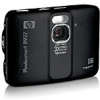HP Photosmart R930 User Guide - Page 56
Managing batteries, Top points about batteries, Extending battery life
 |
View all HP Photosmart R930 manuals
Add to My Manuals
Save this manual to your list of manuals |
Page 56 highlights
A Managing batteries Your camera uses a rechargeable HP Photosmart R07 Lithium Ion battery (L1812A/L1812B). Top points about batteries Always insert the battery in the camera correctly (see "Install the battery" on page 5). If the battery is inserted improperly, the compartment door may close but the camera will not operate. • New rechargeable Lithium Ion batteries are shipped partially charged. Fully charge them before first use. • If you do not intend to use your camera for more than two months, leave the camera connected to AC power using the power adapter that came with your camera. The camera will top off the battery periodically to ensure that the camera is always ready for use. • A rechargeable Lithium Ion battery can be left in the camera or optional quick recharger for any period of time without harm. • If a rechargeable Lithium Ion battery has not been used for more than two months, recharge it before using it again. Fully recharge Lithium Ion batteries every six months to a year to prolong their useful life. • The performance of Lithium Ion batteries degrades over time, especially if stored and used at high temperatures. If battery life is unacceptably short, replace the battery. • The performance of Lithium Ion batteries will decrease as the temperature drops. To improve battery performance, store the camera and batteries in a warm inside pocket when in a cold environment. To prevent short-circuiting the batteries, never carry small metal items such as keys or coins in the same pocket with your batteries. Extending battery life To conserve battery power, the Image Display automatically dims and brightens based on lighting conditions and turns off after 45 seconds by default. Pressing any button wakes up the camera. After five minutes of inactivity, the camera turns off. To further extend battery life: • Set Display Brightness to Low (see Display Brightness under "Using the Camera Setup Menu" on page 42). • Change the Display Timeout value to a shorter interval (see Display Timeout under "Using the Camera Setup Menu" on page 42). • Set your camera to Auto Flash (see Auto Flash under "Setting the flash" on page 16). • Use optical zoom sparingly. • If you are turning on the camera only to view images, slide to , then turn on the camera to start in Playback without zooming the lens. Safety precautions for using batteries • Do not place the battery in fire or heat the battery. Always store charged batteries in a cool location. • Do not connect the positive and negative terminals of the battery to each other with any metal object. • Do not carry or store the battery with metal objects. Do not drop the battery into a change-filled pocket. • Do not pierce the battery or subject it to strong impacts or shocks. • Do not solder directly onto the battery. • Do not allow the battery to get wet. • Do not disassemble or modify the battery. 54 Managing batteries















